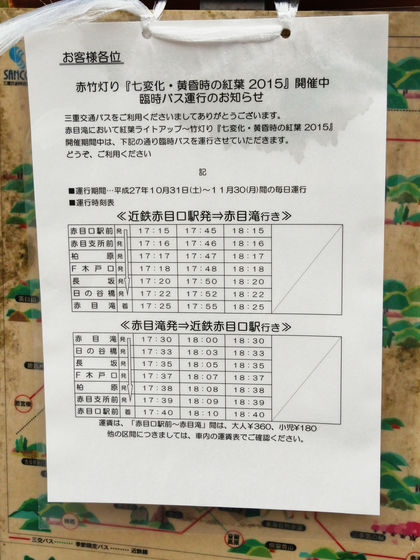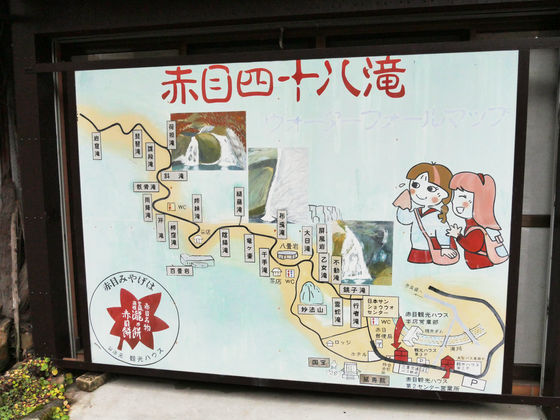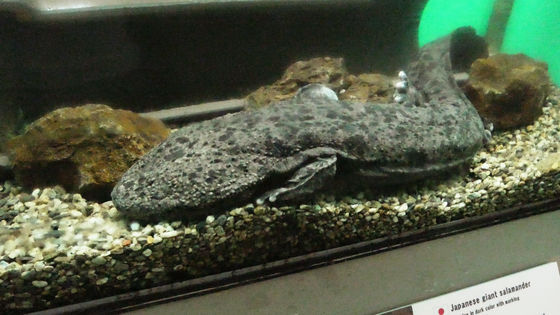I went to the Japan Salamander Center, a museum specializing in salamanders, to see the giant salamanders that grow naturally in the waterfall.

At the foot of Akame 48 Waterfalls in Nabari City, Mie Prefecture, where Japanese giant salamanders naturally inhabit, there is a museum ' Japan Salamander Center ' that specializes in displaying Japanese giant salamanders. Many giant salamanders are bred from larvae to adults, and wild salamanders can be seen in the rivers and waterfalls near the center, so I went there immediately.
Japan Salamander Center | Ninja Training Village Akame 48 Waterfalls
https://www.akame48taki.com/activity_post/ Japan Salamander Center
If you go to Akame 48 Waterfalls by public transportation, Kintetsu Akameguchi Station is the closest. The means of transportation from the station is Mie Kotsu bus or taxi. Buses cost 360 yen one way, but the number of buses is quite small, and taxis cost around 1800 yen, so traveling by car gives you more freedom of movement. However, during the autumn leaves season around mid-November, the roads can get so crowded that cars can't move.

From October 31st (Sat) to November 30th (Mon), 2015, the Akame 48 Waterfalls Illumination Project 'Seven Changes / Autumn Leaves at Twilight 2015' is being held, and three extra buses operate in the evening. I am.

About 10 minutes from the station, I was swayed by a bus and arrived at the foot of Akame 48 Waterfalls.

There is a map across the road after getting off the bus stop ...

Follow the map and proceed to the left from the bus stop.

On the way to Shijuhachi Waterfall, there are souvenir shops and

There are maps everywhere on the side of the road, so it's unlikely that you'll get lost to the giant salamander center.


As you walk along the road, the surrounding scenery gradually becomes more natural.

Along the way, there was 'Janja no Mizu' where water flows from the mouth of the giant salamander. It is said that the water was cleansed and calmed when the red-eyed ninja practiced.

It is made by carving out black stone, and its smooth surface and round shape are cute.

When you reach the end of the road, you will arrive at the 'Japan Salamander Center' where the signboard of the giant salamander is displayed.

At the entrance of the center, there is a mossy water wheel and the atmosphere is perfect.

Buy your ticket at the counter on the left side of the building. The fee is 400 yen for adults and 100 yen for children, and the ticket fee will be used for conservation activities at Akame 48 Waterfalls.

That's why I'm going into the center to meet the giant salamander.

Immediately after entering the entrance, three small aquariums are lined up, and small giant salamanders around the age of 4 to 10 are bred.

The two 4-year-old giant salamanders were still with their eyes wide open, hiding behind the stones, perhaps because they were alert.

The giant salamander is an amphibian, but it rarely comes out of the water, and when it returns from an egg, it lives in the water for the rest of its life.

The 12-year-old giant salamander is secretly hiding in the shadow of a flowerpot and looking around.

The giant salamander that stuck to the corner of the aquarium and did not move.

After a while, when I went to see it, I bent my body along the curve of the figurine and stayed still.

You can see the mini-sized giant salamander swimming in the following movie.
Opposite the chibi salamander aquarium, there is a large aquarium that reproduces the rugged rocky area.

Inside the rock aquarium is the oldest giant salamander, Sanshomaru, which is estimated to be 60 years old, weighs 8550g, and has a total length of 1120mm.

I was swimming around like slow motion while moving the giant slowly.

You can see the giant salamander moving slowly in the aquarium in the following movie.
Going further back, there are smaller aquariums on the left and right of the aisle.

Young giant salamanders aged 20 to 30 live here.

'Nana-chan', who is estimated to be 25 years old, is 510 mm long and weighs about 1 kg. He has a calm and curious personality, and when he visited, he was hiding in the gaps between the rocks and staying still.

'IBUKI' with an estimated age of 45 years. It weighs 3550g and has a total length of 830mm, and has a strong and patient personality. It's as if you're practicing by being hit by water that imitates a waterfall.

'Kotetsu' with an estimated age of 35 years, a weight of 2800g, and a total length of 750mm. He seemed to have a rough and naughty temperament, and his body was sticking out of the cracks in the branches.

'Yuyu' of the Chinese giant salamander, whose personality is super wild. The outline of the face is sharper than that of the Japanese giant salamander, and it looks like a snake.

The estimated age is 60 years old, the owner of a huge body with a weight of 7350 g and a total length of 1060 mm. I lived in a larger aquarium than other giant salamanders.

Only at the center can you see a mixture of Japanese giant salamander and Chinese giant salamander.

In addition to the giant salamander, Japanese newts (Japanese fire belly newts) that live in various parts of Japan ...

An orange-colored Okinawan sword-tailed newt that lives mainly in the Amami Islands. It is designated as a Near Threatened Species.

The Muhanft newt inhabits mountain streams in southeastern China, and is a newt that lives completely underwater and has a thick tail like a fin. Among the newts, it is said to be large and can grow to a total length of about 200 mm.

Axolotl, which is familiar as 'Woo Pearl Looper' in Japan. In the local language, it is called the axolotl, which means 'playing in the water.'


The Iberian ribbed newt, which inhabits Spain, Portugal and Morocco, is the largest growing newt in Europe and lives in lakes and ponds.

The temperature of the aquarium is kept as low as around 10 degrees Celsius, which is the same as the temperature of the river where salamanders and newts live, and the aquarium tends to condense.

There was a wiper to remove the condensation.

Turn right at the end of the aisle ...

You can hike along the river by going out on the walking path of Akame 48 Waterfalls. It seems that you can see wild giant salamanders on this river, so I decided to walk along the river at once.

Many climbers visited the waterfall to see the autumn leaves because the autumn leaves were in full bloom.

By the way, the name 'Akame 48 Waterfalls' comes from the fact that there are many large and small waterfalls.

There are places where the slope is quite steep, and the scaffolding is rocky and slippery, so it is better to equip yourself with climbing equipment.

I couldn't see the giant salamander along the river, but I thought, 'Isn't it going out in the daytime?', And when I asked the patrol staff of Akame 48 Waterfalls, the giant salamander is nocturnal. Basically, it never comes out from behind the rocks in the daytime. 'If you're hungry and can't help, you may come out to eat a small fish called Kawamutu,' said a patrol member. It seems that it is often hidden in the shaded part where the bottom of the big rock is shaved, and in the morning of the day I visited, I heard that I saw a large giant salamander around the 100 tatami rock.

Kawamutu is a small fish with a white streak on its body surface.

So, about an hour after leaving the center, I arrived at Hyakutamiiwa, where a patrol member saw a giant salamander.

There was a teahouse near Hyakutamiiwa, which offered hot menus such as pork soup, oden, and yakisoba.

As I wandered around the riverside, I found a large rock that seems to be a giant salamander!

There was a kawamutu in the shadow of the rock, but I couldn't find the giant salamander no matter how much I searched for it ...

If the giant salamander actually appears on the riverside, it seems that you can see the wild giant salamander up close as shown in the picture below.
What is a giant salamander? Japan Salamander Center

I couldn't see the wild giant salamander, but the stamp rally was held along the hiking course, so I tried to conquer all of them.

There is a stamp inside the hut like this.

If you collect all the stamp rallies, you can get an application postcard at the reception desk of the center.

A souvenir will be presented by lottery. The stamp rally is held until November 30th (Monday).

When I went down the mountain and returned to the center, I found that the exhibition was also held on the second floor.

On the 2nd floor, there is an exhibition of giant salamander goods ...


Specimen of giant salamander.

There are also skeletal specimens.

This is a stained skeletal specimen.

The bony bones are dyed red and the cartilage is dyed blue, and the development and morphology of the skeleton can be seen more clearly.

The Japan Salamander Center is open from 8:30 am to 5:00 pm from April 1st to November 30th, and from 9:00 am to 4:30 pm from December 1st to March 31st. It is closed from December 28th to December 31st.
Related Posts:







